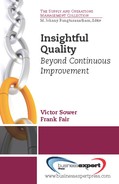In the U.S….we are addicted to simple solutions and silver bullets.
—Shirley Ann Jackson
President, Rensselaer Polytechnic Institute
Warren Bennis said that management is about doing things right while leadership is about doing the right things.1 Of course organizations need both good management and good leadership—they need to do the right things right, but Bennis contended that modern organizations are often under-led and over-managed. It is organizational leadership that is essential to attaining and maintaining market leadership over time, and accomplishing this cannot be done with simple solutions or silver bullets.
Continuous improvement—optimizing processes, reducing costs, eliminating defects—is about doing things right and is vital to an organization’s success. But incremental improvement alone will not assure the long-term success of the organization. Being the low-cost producer of the world’s best 1960s era slide rule will not enable a company to compete in today’s electronic calculator, tablet computer, and PC world. The world’s best floppy disk cannot compete with today’s low end USB flash drives—and new ferroelectric material-based memory devices currently under development promise to render flash drive technology obsolete.2 Today’s consumers are not interested in purchasing slide rules and floppy disks even if they are inexpensive and 100% defect-free. Those are products of an obsolete paradigm, and in many cases the companies that produced them are no longer in existence.
Continuous improvement is essential but not sufficient to assure an organization’s continued success. In order to be a market leader or indeed even to survive in many cases, resources must be devoted to longer term strategic quality activities to address radical—possibly paradigm-shifting—improvements that might affect the organization and its competitive position. These radical improvements might result from R&D efforts within the organization (proactive) that propel the organization and its products and services to the cutting edge of the markets in which they operate. Or these radical improvements might be developed by competitors or even by organizations in other industries (reactive) which, if ignored, might threaten the long-term survival of the organization if they are not recognized and reacted to in an appropriate way. Continuous improvement of the pioneering Palm Pilot produced by Palm, Inc. during the 1990s was insufficient to assure the long-term success of the company. Palm’s attempts to compete successfully in the smart phone market were “thwarted by competitors that simply moved too quickly.”3 The dangers from relying on continuous improvement alone are not restricted to just manufacturing. Service industries are just as vulnerable to radical changes. Borders, a pioneer in book superstores, recently filed for Chapter 11 bankruptcy protection. Shortly thereafter, Borders announced it was closing all of its stores. The company’s troubles are largely due to broadening of marketing channels for books to include more nontraditional outlets and the growing popularity of online sales and electronic books coupled with an overall downturn in the number of books purchased by American consumers.4
This book is about how to think differently about quality and by doing so increase the creativity, innovation, and agility of an organization and its employees as well as the awareness of new developments in the marketplace and their possible impact on the organization and its markets. Quality must be addressed in strategic as well as operational terms in order for organizations to compete effectively over the long term. Strategic quality management requires insightful leadership. This book is about attaining the insight required to increase organizational creativity, innovation, and agility to create new paradigms, and survive paradigm shifts that originate outside the organization. Each chapter contains short case illustrations about real organizations that illustrate the main points of that chapter. Insightful organizations are not only better prepared to react effectively to changes in the competitive environment, but to establish and maintain positions of leadership in their market domains. This book does not describe a detailed process that ostensibly leads to insight. Rather this book takes the position that what works for one organization might not work as effectively for another. It challenges leaders and managers to adopt a new way of thinking and presents thought-provoking ideas about how organizations can begin the process of charting their own paths to insight—and lasting success.
Keywords
Insight, strategic quality management, breakthrough improvement, paradigm shift, continuous improvement, Plato, innovation, creativity, quality, technological forecasting, environmental scanning, benchmarking, house of quality, change management.
